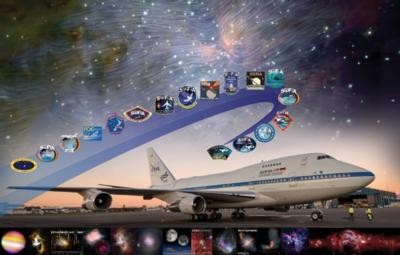Sun, Jan 08, 2023
New Home at Pima Air Museum Will Provide Home for Atmospheric Research Craft
SOFIA, NASA's faithful 747SP, is all set for delivery to its new home at the Pima Air & Space Museum in Tucson, Arizona.

The plane took off for the last time from NASA’s Armstrong Flight Research Center in Palmdale, California, seen off by the local community of maintainers and program personnel before heading out to remain on display. Throughout her time as the SOFIA program's mobile laboratory, the aircraft granted the astrophysical community "unprecedented access to the mid- and far-infrared wavelengths of light," thanks to her considerable data gathering capability far above the 'dirty' magnetic fields of the earth below. From her operating altitude, SOFIA was able to fly above nearly 100% of the water aloft in the atmosphere, allowing those aboard and down below to study cosmic magnetic fields in astrophysics. While similar observatories existed, none were so mobile or feature-rich in such a small (at least smaller than a land-based observatory) package.
The aircraft was the result of a joint NASA and German Space Agency effort at DLR. DLR provided the telescope, scheduled aircraft maintenance, and other support for the mission. NASA’s Ames Research Center in California’s Silicon Valley managed the SOFIA program, science, and mission operations in cooperation with the Universities Space Research Association, headquartered in Columbia, Maryland, and the German SOFIA Institute at the University of Stuttgart.
“We want to express our gratitude to everyone, both our U.S. and German colleagues, who, over the years, developed, tested, and operated the observatory at Ames and Armstrong. It has been an incredible team effort to create and operate the world’s largest airborne observatory. None of this would have been possible without the community of scientists who have used and supported SOFIA over the years. We look forward to hearing everything the SOFIA scientific community learns as we go on. It is with heartfelt thanks that we at NASA say goodbye to SOFIA. We are sad to see you go but so happy to have worked with the SOFIA team.”
More News
Known Traffic With respect to ATC clearances, means aircraft whose altitude, position, and intentions are known to ATC.>[...]
Aero Linx: Aviation Suppliers Association (ASA) Established February 25, 1993, the Aviation Suppliers Association (ASA), based in Washington, D.C., is a not-for-profit association,>[...]
Abeam An aircraft is “abeam” a fix, point, or object when that fix, point, or object is approximately 90 degrees to the right or left of the aircraft track. Abeam indic>[...]
Aero Linx: The Air Charter Safety Alliance The group, called the Air Charter Safety Alliance, will raise awareness of illegal charter flights among potential customers, charter bro>[...]
“For months, ALPA has been sounding the alarm on the ongoing efforts by some aircraft manufacturers to remove pilots from the flight deck and replace them with automation. To>[...]
 ANN's Daily Aero-Term (06.10.24): Known Traffic
ANN's Daily Aero-Term (06.10.24): Known Traffic ANN's Daily Aero-Linx (06.10.24)
ANN's Daily Aero-Linx (06.10.24) ANN's Daily Aero-Term (06.11.24): Abeam
ANN's Daily Aero-Term (06.11.24): Abeam ANN's Daily Aero-Linx (06.11.24)
ANN's Daily Aero-Linx (06.11.24) Aero-News: Quote of the Day (06.11.24)
Aero-News: Quote of the Day (06.11.24)



